When to plant shallots?
by Diane - September 5th, 2012.Filed under: allotment, Thompson and Morgan.
When to plant shallots? The general advice is autumn! I’ve read it’s anytime from September to mid-March – depending I expect on where you are and what soil you have. If your soil is likely to be sodden over Christmas then leave it until later to plant.
You want to plant them in a nice fine soil bed, so dig, rake and leave to settle and then cull any sneaky weeds that pop up again! If the soil is very soggy then think about using a raised bed. Don’t plant in fresh muck but if you have some very well rotted stuff then dig some of that in a few weeks before hand.
Round here it’s useful to cover with chicken wire to stop the birds pulling them out. As you plant them so the tip is showing then you’ll find the birds think this is something edible for them and they’ll pull it out.
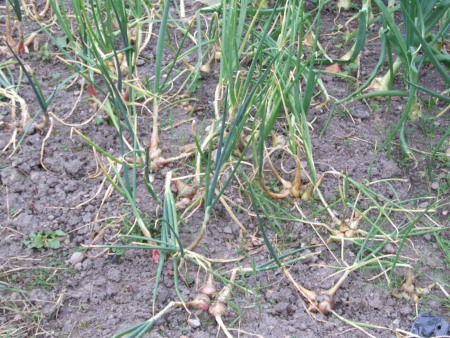
Harvest them when the leaves are all folding down – usually Harvesting: June – July, or August. The bulb you plant turns into several bulbs. Many people save some of their own grown shallots for replanting. My dad told me they were very easy to grow and he was right! They’re good for cooking with or using as pickling onions.
When to plant shallots? Read the packet you bought them in – or go with your gut instinct. They do need some cold to get started growing so don’t be in too much of a rush!
Whilst you’re growing these you can add some specialised onion fertiliser, or just use normal fertiliser – a general purpose one. Some people like to buy specific ones for specific crops but a general purpose one is cheaper as you can use it on everything. Don’t forget to weed though – they need light and air around them. A dense coverage of weeds will limit their growth.
If you hoe shallots you have to be very careful not to accidentally displace the bulbs. Hand weeding is more tedious but can be safer if you’re a bit clumsy with the hoe. If you know you’d rather hoe then make sure the bulbs are well spaced so it’s easier to get in between the rows. working from one side and then at 90 degrees means you can go between rows and do straight lines of hoeing which should make life easier.
Planting shallots is hard work. You just press the bulbs in carefully. Many people suggest you work from a board when planting so that you don’t treat on the soil and create footprint shaped condensed patches of soil.
Don’t force shallots in to very hard soil. Rake to get a fine tilth first so that they go in easily. The delicate root plate under the shallot needs to go in without being scraped. Its from here that the roots grow after you’ve planted the shallot bulbs. Plant them so the tops just peep out of the soil.
Plant them about 6″ apart in rows about twice that apart. Make sure you can get in between to hoe easily so you can help keep the weeds down.
They are very easy to grow – need little fuss once you’ve put them in. If they start to produce flowers just cut them off but they dn’t do this as much as onions do!
want to fertilise shallots?
Chempak® Onion Fertiliser – 12 x 1.2kg packs £60.00
Brimstone Rapide – 1 x 600g pack £9.99
Chempak® Onion Fertiliser – 1 x 1.2kg pack £7.99
Onion Fertiliser – 6kg bag – for 300 planting sets £6.99
Onion Fertiliser – 3kg bag – for 150 planting sets £4.99
Want to order some shallots now?
Decided you want to grow shallots?
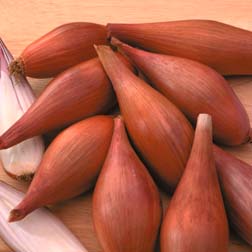
Shallot ‘Banana’ – 1 packet (200 seeds) £2.69
Long, banana-shaped shallots from seed, as used by many celebrity chefs. Banana Shallot produces attractive, shiny, copper brown-skinned bulbs with crisp white flesh and a very distinct flavour. Sowing densities will determine the size of bulbs you harvest. Stores well for winter use in the kitchen.
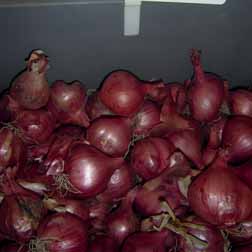
Shallot ‘Camelot’ F1 Hybrid – 1 packet (60 seeds) £2.89
You’ll love this visually stunning shallot – the darkest red-skinned variety available from seed. Shallots have become increasingly popular for their culinary uses as they have such a distinctive flavour, offering an interesting alternative to onions. Each seed produces an individual small, whitefleshed bulb which stores extremely well for use throughout late autumn and winter.
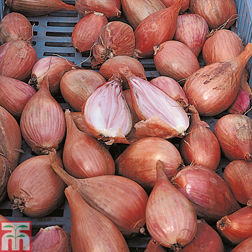
Shallot ‘French Longor’ – 1kg pack £8.99
This French version of ‘Jersey Long’ has been awarded an RHS Award of garden merit for its extremely long bulbs and robust flavour. Shallots have a much sweeter flavour than onions and can be used in stews and casseroles for a more delicate taste. This variety is a particular favourite with exhibition growers, and can be stored over a long period.
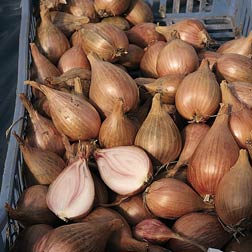
Shallot ‘Jermor’ (Autumn Planting) – 1 pack £6.99
Autumn Planting. Often referred to as ‘banana’ shallots by chefs and foodies, Jermor is from French production of Jersey ‘half long’ type shallots with long, rather than round bulbs. Highly rated for their flavour and increasingly sought after for gourmet recipes due to their superb sweet taste. The shiny copper-skinned bulbs with crisp, pink-tinged flesh make Jermor a favourite with exhibitors. Good storage potential.
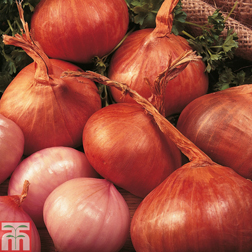
Shallot ‘Red Sun’ – 1 pack £4.99
Spring planting.Gaining in popularity due to its attractive red tinged skin, Shallot ‘Red Sun’ is arguably the best of the red shallots. Producing good yields of crisp, white fleshed bulbs of excellent flavour for cooking, salads or for pickling. Bulbs have long storage potential. Pack size: Approx 500g, approx 15-20 sets. Height: 35cm (14”). Spread: 15cm (6”).
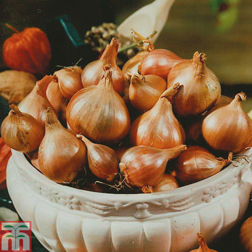
Shallot ‘Springfield’ – 1 pack £4.99
Spring planting.These high yielding, shiny bronzed-skinned shallots have good bolting resistance. The reddish tinted flesh of Shallot ‘Springfield’ has a strong flavour so is ideal for pickling/stews and casseroles. Bulbs store very well. Pack size: Approx 500g, approx 15-20 sets. Height: 35cm (14”). Spread: 15cm (6”).






